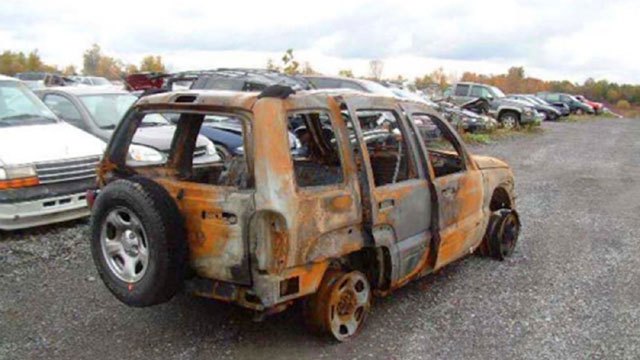Balls Of Fire, Then And Now
Chrysler’s recent decision to snub a recent NHTSA recall request is big news. I need not restate the facts of the story, if you are a “car guy” and haven’t heard the sordid details, or noticed the dramatic photos of burned out Jeep Grand Cherokees and Liberties posted all over the internet in the past few days, you must live under a rock. With 2.7 million vehicles involved the costs of conducting such a recall would be staggering but, ultimately, inaction may cost the company even more money if consumers lose confidence in the brand.
Because the root cause of the recall is said to involve rear-end collisions, ruptured fuel tanks, and the possibility of a death so gruesome that most of us shudder to even think about it, people are drawing a natural comparison between the current case and the Ford Pinto debacle of the 1970s. They appear the same on the surface but that’s only because, as much as I am loathe to admit it, the ‘70s were a long time ago and public awareness of the details of that earlier case has wasted away. In their rush to assert that history is repeating itself, people leap over a critical piece of the story that makes what happened almost 40 years ago much, much worse. Namely that Ford knew about the tendency of the Pinto to explode before the cars even left the factory, and, because it would cost an extra $11 per car to fix, they elected not to act.
The case against Ford was laid out in great detail by Mother Jones News in their October 1977 issue – view the original article – and it makes chilling reading. In a nutshell, that article states that the problems with the Pinto’s fuel tank became apparent during pre-production crash tests, but that Ford elected to go ahead with the car as designed because the tooling for the cars was already in place and because the overall cost to upgrade the car was deemed to be higher than the cost potential settlements to the families of those people unfortunate enough to be burned alive in an accident. Mother Jones backed up this assertion with a leaked Ford memo that revealed that an internal cost-benefit analysis had determined that the company’s average estimated payout in the event of a death caused by the defect would be $200,000. Crunching the numbers, then, was simple: $11 times X million cars over the car’s product cycle vs $200,000 times a projected 180 burn deaths per year. Chillingly logical, isn’t it?
Once Mother Jones blew the lid off this story, people got enraged and Pinto sales dropped precipitously. In 1977, seven full years after the car’s introduction, Ford finally made the required modifications and the car continued to appear on Ford lots where it sold in much smaller numbers until it finally went away in 1980. Today, the Ford Pinto has virtually vanished from the streets and, when they do appear, they seem more an oddity than a rolling death trap released upon the world through corporate duplicity.
I suppose that those whose lives have been effected by current “alleged” defect in Chrysler’s Jeeps will care little about the distinction I make between a vehicle that is determined after the fact to have a possibly deadly defect and one that left the factory with a similar defect with the full knowledge of the people running the program, but to me the difference is an important one. One is a mistake, the other is murder. One deserves to be prosecuted and the other made right. Both, however, need to be remembered in their correct context.
Even so, Chrysler should not ignore the lesson that Ford learned in the ensuing debacle. People don’t like to be burned alive in their cars. We don’t even like the thought of it. Over time we may forget the specific details, but we will remember the part about the burning. Don’t forget that. Make this right before its too late.
Thomas Kreutzer currently lives in Buffalo, New York with his wife and three children but has spent most of his adult life overseas. He has lived in Japan for 9 years, Jamaica for 2 and spent almost 5 years as a US Merchant Mariner serving primarily in the Pacific. A long time auto and motorcycle enthusiast he has pursued his hobbies whenever possible. He writes for any car website that will have him and enjoys public speaking. According to his wife, his favorite subject is himself.
More by Thomas Kreutzer
Latest Car Reviews
Read moreLatest Product Reviews
Read moreRecent Comments
- Dave Holzman My '08 Civic (stick, 159k on the clock) is my favorite car that I've ever owned. If I had to choose between the current Civic and Corolla, I'd test drive 'em (with stick), and see how they felt. But I'd be approaching this choice partial to the Civic. I would not want any sort of automatic transmission, or the turbo engine.
- Merc190 I would say Civic Si all the way if it still revved to 8300 rpm with no turbo. But nowadays I would pick the Corolla because I think they have a more clear idea on their respective models identity and mission. I also believe Toyota has a higher standard for quality.
- Dave Holzman I think we're mixing up a few things here. I won't swear to it, but I'd be damned surprised if they were putting fire retardant in the seats of any cars from the '50s, or even the '60s. I can't quite conjure up the new car smell of the '57 Chevy my parents bought on October 17th of that year... but I could do so--vividly--until the last five years or so. I loved that scent, and when I smelled it, I could see the snow on Hollis Street in Cambridge Mass, as one or the other parent got ready to drive me to nursery school, and I could remember staring up at the sky on Christmas Eve, 1957, wondering if I might see Santa Claus flying overhead in his sleigh. No, I don't think the fire retardant on the foam in the seats of 21st (and maybe late 20th) century cars has anything to do with new car smell. (That doesn't mean new car small lacked toxicity--it probably had some.)
- ToolGuy Is this a website or a podcast with homework? You want me to answer the QOTD before I listen to the podcast? Last time I worked on one of our vehicles (2010 RAV4 2.5L L4) was this past week -- replaced the right front passenger window regulator (only problem turned out to be two loose screws, but went ahead and installed the new part), replaced a bulb in the dash, finally ordered new upper dash finishers (non-OEM) because I cracked one of them ~2 years ago.Looked at the mileage (157K) and scratched my head and proactively ordered plugs, coils, PCV valve, air filter and a spare oil filter, plus a new oil filter housing (for the weirdo cartridge-type filter). Those might go in tomorrow. Is this interesting to you? It ain't that interesting to me. 😉The more intriguing part to me, is I have noticed some 'blowby' (but is it) when the oil filler cap is removed which I don't think was there before. But of course I'm old and forgetful. Is it worth doing a compression test? Leakdown test? Perhaps if a guy were already replacing the plugs...
- Crown No surprise there. The toxic chemical stew of outgassing.


































Comments
Join the conversation
They did a Pinto styled recall on my 1977 Chevrolet Chevette. Added a plastic shield between the fuel tank and rear differential. I wonder if it was a proactive fix or they had as many fires as Ford.
Well said Thomas . Driving is dangerous no matter how you look at it ~ I was waiting at a red light on my Moto in 2008 , 04:30 when I was rear ended by a gypsy cab and nearly killed ~ it just happens sometimes . Although I own several Mercedes W-123s , I vastly prefer driving my '69 Chevy C/10 pickup or 1959 Metropolitan Nash Fixed Head Coupe everywhere I go , including Death Valley etc. Both are DEATH TRAPS but . life is uncertain , instead of living in a cocoon and crying myself to sleep , I embrace life and if I die , so be it . You alls might want to read up on what actually happens when you " burn to death " because you don't ~ you suffocate after the hot gasses & air burn away the bronchial matter in your lungs.... For real fun , look at the old safety test films of GM pickups being center punched with the in cab's fuel tank full of red dyed fuel ~ scarier than anything I've ever experienced but I still drive it daily . -Nate